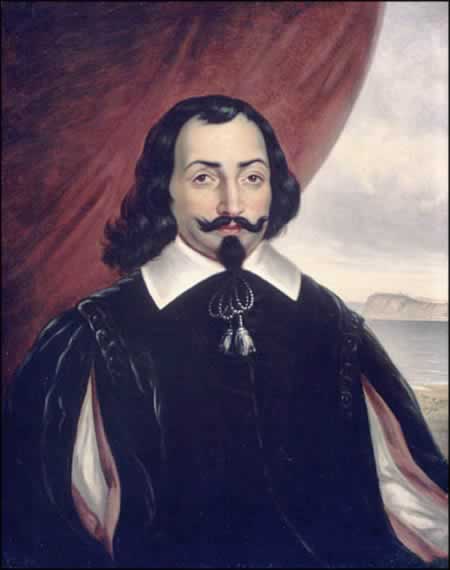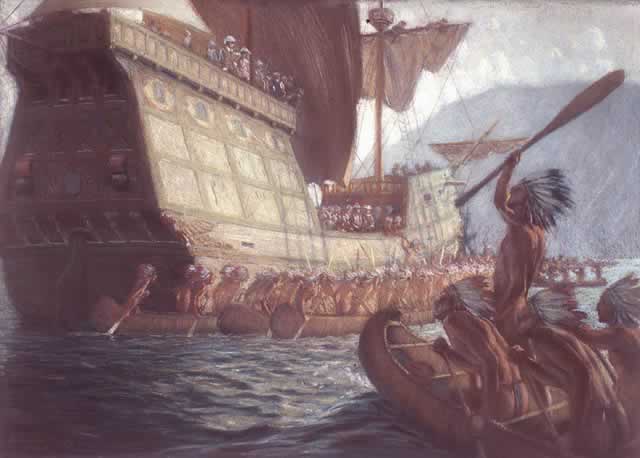Think that you own a portrait of Samuel de Champlain? We identify, appraise and issue Certificates of Authenticity (COA) for all portraits of Samuel de Champlain.

Samuel de Champlain by Theophile Hamel Moncornet
Samuel de Champlain , the "father of New France," was born between 1567 and 1570 in the town of Brouage, a seaport on France's west coast and died in 1635 in Québec. A sailor, he also came to be respected as a talented navigator, mapmaker, and founder of Quebec City. He was also integral in opening North America up to French trade, especially the fur trade. Champlain's pattern was to spend several months or years exploring North America and then to head back to France to raise more funds for further explorations.

Samuel de Champlain in Armor, artist unknown
He was born in Brouage, France in around 1567 that was reported in the title of his 1603 book but much of Champlain's early life is unknown: it is speculated by some that his mother was a Huguenot. He arrived on his first trip to North America on March 15, 1603, a member of a fur-trading expedition. Although he had no official assignment on the voyage, he created a map of the St. Lawrence River and after his return to France on September 20, wrote an account published as Des Sauvages: ou voyage de Samuel Champlain, de Brouages, faite en la France nouvelle l'an 1603 ("Of Savages: or travels of Samuel Champlain, of Brouages, made in New France the year 1603"). Instructed by Henry IV to make a report on his further discoveries, Champlain joined another expedition to New France led by Pierre Dugua, Sieur de Monts in the spring of 1604. He helped found the Saint Croix Island settlement in the Bay of Fundy. However, after enduring a harsh winter on the island, the settlement was abandoned the following spring when Champlain relocated the settlers to the Fundy coast of Nova Scotia at Port Royal. Champlain remained at the site until 1607, while he explored the Atlantic coast.
In 1605 and 1606, Champlain explored the land that is now Chatham, Cape Cod as a prospective settlement but small skirmishes with the resident Monomoyick Indians dissuaded him from the idea. He named the area Port Fortune.
In the spring of 1609, three ships left the French port of Honfleur, one of them the Don-de-Dieu commanded by Champlain. In June, the small group of settlers arrived at Tadoussac. There, they left the ships and continued to Québec in small boats. On July 3, 1609, Champlain landed at the "point of Quebec" and set about fortifying the area by building three main buildings (each two stories tall), to which he referred collectively as "l'Abitation"), and also a moat 15 feet (5 m) wide. This was to become the city of Quebec. Fortifying Quebec City became one of his passions, which he embarked on periodically for the rest of his life.

Samule de Champlain Arrives in Quebec by George Agnew Reid, 1909
In October of 1635, Champlain was stricken with paralysis and stroke. He died childless on December 25, 1635. He was buried temporarily in an unmarked grave while construction was finished on the chapel of Monsieur le Gouverneur. Unfortunately, it was destroyed by fire in 1640 and immediately rebuilt but nothing is known of it after 1640, although after 1674 it no longer existed. As such the exact burial site of Champlain is unknown. However, Jesuit records tell us he died in the hands of his friend Charles Lallemant who also heard his last confession, a reassuring point for a Catholic of the period.
There is no authentic portrait of Champlain. The only surviving picture we have of him is a drawing illustrating the battle at Lake Champlain in 1609, in which the facial features are too vague to make out. Some much-reproduced fictional "portraits of Champlain" have been shown to be actually made after a portrait of Michel Particelli d'Émery, by Balthasar Moncornet.
Could that strange portrait in your family collection be an authentic portrait of Champlain painted during his lifetime? If so, it could be very valuable indeed…contact us to find out.
